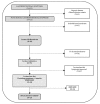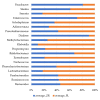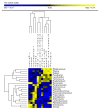Effects of Bifidobacterium longum and Lactobacillus rhamnosus on Gut Microbiota in Patients with Lactose Intolerance and Persisting Functional Gastrointestinal Symptoms: A Randomised, Double-Blind, Cross-Over Study
- PMID: 31010241
- PMCID: PMC6520754
- DOI: 10.3390/nu11040886
Effects of Bifidobacterium longum and Lactobacillus rhamnosus on Gut Microbiota in Patients with Lactose Intolerance and Persisting Functional Gastrointestinal Symptoms: A Randomised, Double-Blind, Cross-Over Study
Abstract
Functional gastrointestinal symptoms are frequent, and may be driven by several pathogenic mechanisms. Symptoms may persist in lactose intolerant (LI) patients (i.e., subjects with intestinal lactase deficiency, lactose malabsorption producing symptoms), after a lactose-free diet. Our hypothesis was that probiotic and vitamin B6 treatment may be useful to alleviate symptoms in LI patients through a positive modulation of gut microbial composition and relative metabolism. We aimed to test the efficacy of a novel formulation of Bifidobacterium longum BB536 and Lactobacillus rhamnosus HN001 plus vitamin B6 (ZR) in 23 LI subjects with persistent symptoms during a lactose-free diet. Symptoms, microbiome, and metabolome were measured at baseline and after 30 days in a crossover, randomized, double-blind study of ZR versus placebo (PL). Compared with PL, the administration of probiotics and vitamin B6 significantly decreased bloating (p = 0.028) and ameliorated constipation (p = 0.045). Fecal microbiome differed between ZR and PL. ZR drove the enrichment of several genera involved in lactose digestion including Bifidobacerium. Moreover, the relative abundance of acetic acid, 2-methyl-propanoic acid, nonenal, and indolizine 3-methyl increased, while phenol decreased. Our findings highlight the importance of selected probiotics and vitamin B6 to alleviate symptoms and gut dysbiosis in lactose intolerant patients with persistent functional gastrointestinal symptoms.
Keywords: lactose intolerance; metabolome; microbiome; probiotics; vitamin B6.
Conflict of interest statement
The authors declare no conflict of interest. The funders had no role in the design of the study; in the collection, analyses, or interpretation of data; in the writing of the manuscript; or in the decision to publish the results.
Figures






Similar articles
-
Effect of Lactobacillus rhamnosus HN001 and Bifidobacterium longum BB536 on the healthy gut microbiota composition at phyla and species level: A preliminary study.World J Gastroenterol. 2017 Apr 21;23(15):2696-2704. doi: 10.3748/wjg.v23.i15.2696. World J Gastroenterol. 2017. PMID: 28487606 Free PMC article. Clinical Trial.
-
Effects of Bifidobacterium longum BB536 and Lactobacillus rhamnosus HN001 in IBS patients.Eur J Clin Invest. 2020 Mar;50(3):e13201. doi: 10.1111/eci.13201. Epub 2020 Feb 12. Eur J Clin Invest. 2020. PMID: 31960952 Clinical Trial.
-
Effects of Prebiotic and Probiotic Supplementation on Lactase Deficiency and Lactose Intolerance: A Systematic Review of Controlled Trials.Nutrients. 2020 May 20;12(5):1487. doi: 10.3390/nu12051487. Nutrients. 2020. PMID: 32443748 Free PMC article.
-
Beneficial effects of long-term consumption of a probiotic combination of Lactobacillus casei Shirota and Bifidobacterium breve Yakult may persist after suspension of therapy in lactose-intolerant patients.Nutr Clin Pract. 2012 Apr;27(2):247-51. doi: 10.1177/0884533612440289. Epub 2012 Mar 8. Nutr Clin Pract. 2012. PMID: 22402407
-
The effects of probiotics in lactose intolerance: A systematic review.Crit Rev Food Sci Nutr. 2019;59(11):1675-1683. doi: 10.1080/10408398.2018.1425977. Epub 2018 Feb 9. Crit Rev Food Sci Nutr. 2019. PMID: 29425071
Cited by
-
A Comprehensive Look at the -13910 C>T LCT Gene Polymorphism as a Molecular Marker for Vitamin D and Calcium Levels in Young Adults in Central and Eastern Europe: A Preliminary Study.Int J Mol Sci. 2023 Jun 15;24(12):10191. doi: 10.3390/ijms241210191. Int J Mol Sci. 2023. PMID: 37373338 Free PMC article.
-
Metabolites in the Dance: Deciphering Gut-Microbiota-Mediated Metabolic Reprogramming of the Breast Tumor Microenvironment.Cancers (Basel). 2024 Dec 11;16(24):4132. doi: 10.3390/cancers16244132. Cancers (Basel). 2024. PMID: 39766032 Free PMC article. Review.
-
Exploring the gut microbiome's influence on cancer-associated anemia: Mechanisms, clinical challenges, and innovative therapies.World J Gastrointest Pharmacol Ther. 2025 Jun 5;16(2):105375. doi: 10.4292/wjgpt.v16.i2.105375. World J Gastrointest Pharmacol Ther. 2025. PMID: 40575364 Free PMC article.
-
B Vitamins and Their Roles in Gut Health.Microorganisms. 2022 Jun 7;10(6):1168. doi: 10.3390/microorganisms10061168. Microorganisms. 2022. PMID: 35744686 Free PMC article. Review.
-
The Enzymatic Hydrolysis of Human Milk Oligosaccharides and Prebiotic Sugars from LAB Isolated from Breast Milk.Microorganisms. 2023 Jul 27;11(8):1904. doi: 10.3390/microorganisms11081904. Microorganisms. 2023. PMID: 37630464 Free PMC article.
References
-
- Portincasa P., Moschetta A., Baldassarre G., Altomare D.F., Palasciano G. Pan-enteric dysmotility, impaired quality of life and alexithymia in a large group of patients meeting ROME II criteria for irritable bowel syndrome. World J. Gastroenterol. 2003;9:2293–2299. doi: 10.3748/wjg.v9.i10.2293. - DOI - PMC - PubMed
-
- Liebert A., Lopez S., Jones B.L., Montalva N., Gerbault P., Lau W., Thomas M.G., Bradman N., Maniatis N., Swallow D.M. World-wide distributions of lactase persistence alleles and the complex effects of recombination and selection. Hum. Genet. 2017;136:1445–1453. doi: 10.1007/s00439-017-1847-y. - DOI - PMC - PubMed
Publication types
MeSH terms
Substances
Grants and funding
LinkOut - more resources
Full Text Sources
Medical

